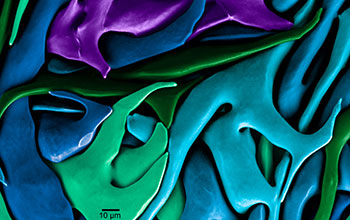Multimedia Gallery
"Biomineral Single Crystals"
"Biomineral Single Crystals," by Pupa U.P.A. Gilbert and Christopher E. Killian, University of Wisconsin, Madison.
These fantastical structures are the microscopic crystals that make up a sea urchin's tooth. Each shade of blue, aqua, green and purple -- superimposed with Photoshop on a scanning electron micrograph (SEM) -- highlights an individual crystal of calcite, the abundant carbonate mineral found in limestone, marble and shells.
The curved surfaces of the crystals look nothing like normal calcite crystal faces. Instead of flat sides and sharp edges, the sea urchin produces "incredibly complex, intertwined" curved plates and fibers that interlock and fill space in the tooth as they grow. Though made of a substance normally as soft as chalk, the teeth are hard enough to grind rock, gnawing holes where the sea urchins take shelter from rough seas and predators. [Research supported in part by NSF grant DMR 11-05167.]
This image won first place and people's choice in the photography category of the 2012 Visualization Challenge, now called the Vizzies, a long-running, annual competition co-sponsored by the National Science Foundation (NSF) and Popular Science magazine. [The competition was formerly named the International Science & Engineering Visualization Challenge (SciVis) and was previously co-sponsored with AAAS' journal Science.] The competition aims to recognize some of the most beautiful visualizations from the worlds of science and engineering, and awards prizes in five categories: photography, video, illustration, posters & graphics and interactives.
To learn more about the competition and view all the winning entries, past and present, see the NSF Special Report The VIZZIES: Visualization Challenge. (Date image taken: 2010-2012; date originally posted to NSF Multimedia Gallery: Nov. 9, 2015)
Credit: Pupa U.P.A. Gilbert and Christopher E. Killian
See other images like this on your iPhone or iPad download NSF Science Zone on the Apple App Store.
Images and other media in the National Science Foundation Multimedia Gallery are available for use in print and electronic material by NSF employees, members of the media, university staff, teachers and the general public. All media in the gallery are intended for personal, educational and nonprofit/non-commercial use only.
Images credited to the National Science Foundation, a federal agency, are in the public domain. The images were created by employees of the United States Government as part of their official duties or prepared by contractors as "works for hire" for NSF. You may freely use NSF-credited images and, at your discretion, credit NSF with a "Courtesy: National Science Foundation" notation.
Additional information about general usage can be found in Conditions.
Also Available:
Download the high-resolution JPG version of the image. (4.4 MB)
Use your mouse to right-click (Mac users may need to Ctrl-click) the link above and choose the option that will save the file or target to your computer.

